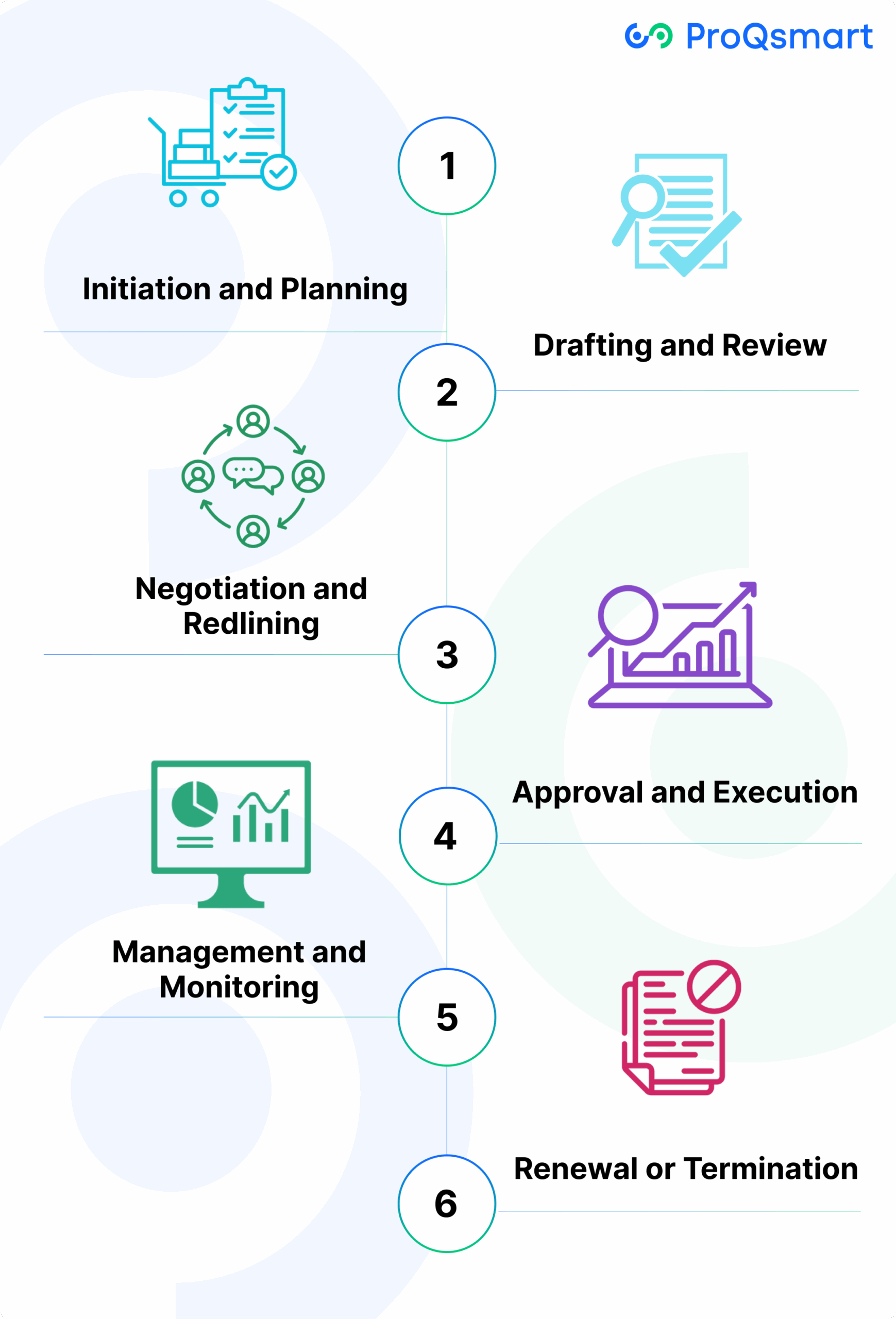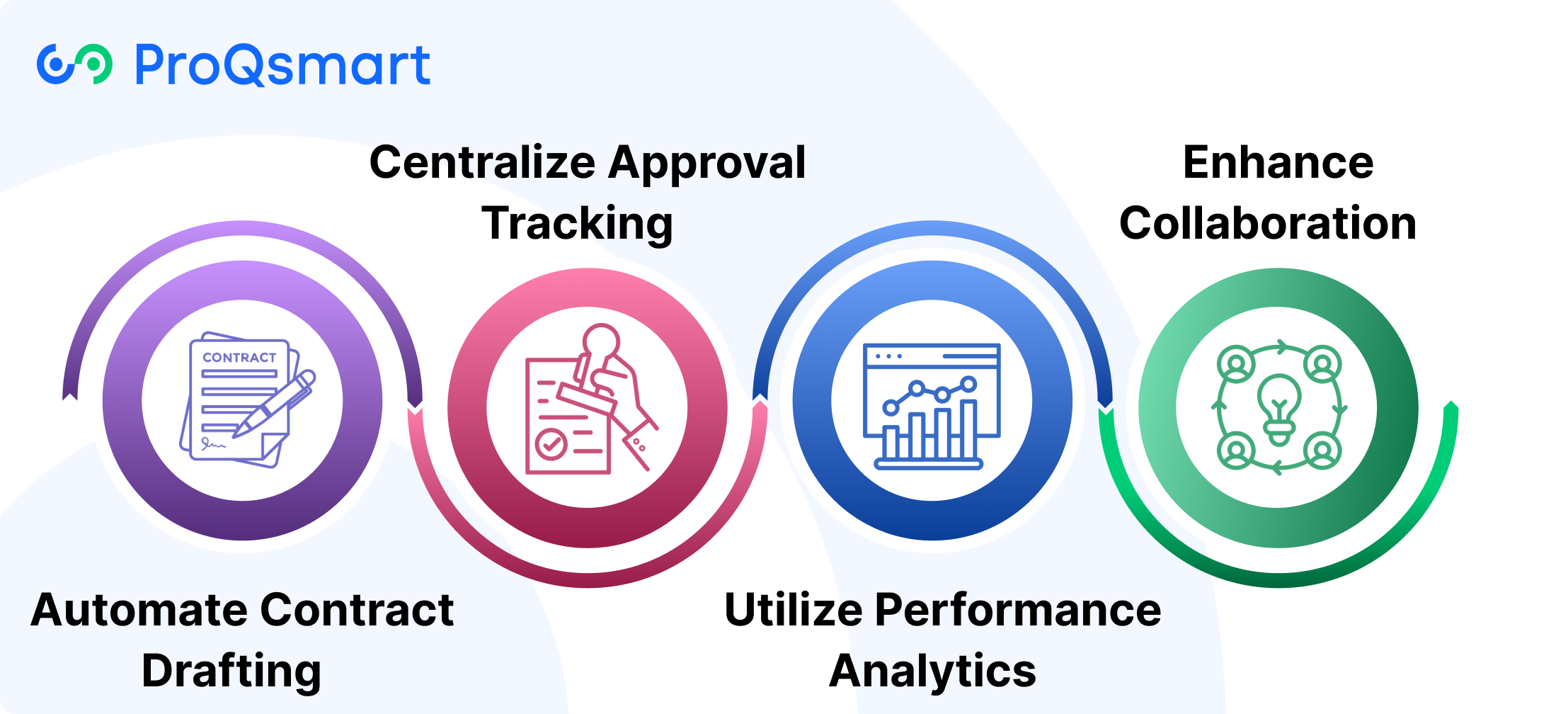The contract lifecycle is built on several key stages. It begins with creation and negotiation, moves on to execution, then to performance monitoring, and finally to renewal or termination. Each phase is an important part of the process, making sure agreements are in sync with business objectives, compliance requirements, and budgetary needs.
Effective contract lifecycle management leads to better operational efficiency by lowering risk, fostering better supplier relationships, and providing greater accountability of deliverables. For procurement professionals, knowing the lifecycle is essential to producing defined workflows, identifying and accounting for obligations, and fostering better decision-making across an organization.
Harnessing contract management tools like CLM can take that efficiency even further. These tools give your legal team visibility and control over every step in the lifecycle. On this blog, we will explore realistic tactics for optimizing every step of the contract lifecycle.
Role of Contract Lifecycle in Procurement
The methodical approach makes certain that each phase of the lifecycle is carefully controlled, allowing organizations to refine and perfect their procurement processes.
By understanding the intricacies of each phase, businesses can streamline operations and identify opportunities to reduce errors and improve compliance. Take, for instance, an example of transaction inefficiency causing organizations to bleed 3-4% of their procurement outflow. Filling these gaps with proper lifecycle management can save millions.
Yet a well-managed contract lifecycle can be key to reducing those risks. Centralized repositories, like those offered by ProQsmart solutions, make it easy to access all contract data at any time, creating transparency and accountability. This transparency empowers businesses to audit spending categories, track supplier performance, and enforce standardized processes, reducing legal risks and driving operational efficiency.
Capabilities such as supplier performance monitoring and subcontractor management deepen stakeholder decision-making and collaboration. Even more importantly, these tools increase procurement’s strategic capacity by not only reducing manual effort but freeing up resources for strategic priorities.
Standardizing templates and processes. Streamlining negotiations. This method reduces the burden on administration and increases transparency of role and responsibility.
Stages of the Contract Lifecycle

Managing contracts effectively requires a structured approach that breaks the lifecycle into six distinct stages:
-
Initiation and Planning
-
Drafting and Review
-
Negotiation and Redlining
-
Approval and Execution
-
Management and Monitoring
-
Renewal or Termination
These stages provide a natural structure to help you categorize, monitor, and improve each step of contract management. Similar to personal finance tools, every step of the contract execution process has a distinct purpose. A bank statement acts as the scorecard, an app for monitoring spending, and a smart advisor for critical guidance.
With the help of CLM tools like ProQsmart, this lifecycle is maintained by automating processes, reducing risk, and improving overall efficiency.
Initiation and Planning
Commencing a contract starts with recognizing the requirements of the organization and matching them with the desired outcomes. Essential steps include clearly defining goals and contract scope, establishing timelines and budgets, and identifying key stakeholders.
Early stakeholder engagement helps ensure that requirements are as comprehensive as possible. For example, involving procurement, legal, and finance teams from the beginning helps avoid details that might be missed down the line.
Drafting and Review
The drafting stage is all about creating clear, compliant, mutually beneficial contracts. Some best practices are utilizing standardized, approved templates and making sure all contract terms have been legally vetted.
An accurate review process prevents issues from reaching the execution phase – both saving time and minimizing risk. This feedback from legal teams helps ensure the contract complies with legal and regulatory requirements.
Negotiation and Redlining
Great negotiation is built on preparation. Tactics such as active listening and seeking win-win solutions create positive outcomes.
Redlining tools to map disinvestment and reinvestment, and then trace change, make working together much easier. With open lines of communication, many disputes are resolved quickly and easily.
Approval and Execution
Approval should be a clearly defined process within the contract management lifecycle, supported by contract management systems. ProQsmart helps automate this process with clear workflow automation, ensuring everyone understands their commitments before the contract gets executed.
Management and Monitoring
Ongoing contract management involves tracking contract performance through KPIs, and ProQsmart’s powerful contract management software provides instant, real-time visibility to ensure all of your suppliers are compliant.
Renewal or Termination
During the contract renewal phase, ProQsmart enhances the contract management process by utilizing extensive performance data and continuous supplier monitoring capabilities for informed decision-making.
Optimizing Each Stage of Contract Lifecycle

Improved operational continuity, reduced risk, and more productive relationships – all made achievable through efficient contract lifecycle management (CLM) – create a lot of downstream benefits. Build to optimize automation, collaboration, and analytics to streamline and improve every step of your contract lifecycle process.
Taking this end-to-end approach will deliver transformational value back to your organization.
Automate Contract Drafting
Automation tools are changing the way contracts are drafted by automating repetitive and error-prone tasks. By taking advantage of platforms such as ProQsmart, you can start to use standardized templates to promote uniformity and save time.
Collaborative features like real-time editing and feedback streamline communications between legal, procurement, and other internal teams. AI-driven tools simplify data extraction, automate risk analysis, and manage contractual obligations, allowing you to focus on crafting precise, tailored agreements.
Centralize Approval Tracking
Visibility into approval workflows across the organization through a centralized system helps avoid bottlenecks. Real-time, digital dashboards and automated alerts prevent approvals from lagging by ensuring everyone involved can take action before deadlines pass.
ProQsmart’s automated workflows and compliance tracking allow stakeholders to define clear roles, responsibilities, and timelines, maintaining momentum and avoiding costly delays.
Utilize Performance Analytics
Leverage AI tools to analyze data to track supplier performance and contract results. Tools such as ProQsmart measure supplier compliance, track performance metrics, and identify areas for improvement.
Renewals data-driven insights help organizations make better renewal decisions and form smarter negotiation strategies, improving supplier relationships while driving more significant cost savings.
Enhance Collaboration
Encouraging collaboration between your procurement team and other stakeholders is essential for harmonizing goals and priorities between departments. ProQsmart’s integrated, real-time collaboration tools enhance communication, document sharing, and transparency among stakeholders.
Bringing everyone to the table in cross-functional meetings promotes inclusivity, helping find ways contracts can further the organization’s goals. Creating a centralized repository is another step towards consolidating contracts, improving their accessibility and security.
Best Practices for Contract Management
Proactive and effective contract management is the key to staying operationally efficient, compliant, and on track to meet your organization’s mission. Always return to your stated objectives and goals, and review consistently. Protect your contract repository, and employ cutting-edge contract management software to automate the contract lifecycle management process and derive value at every point in the entire lifecycle.
Establish Clear Objectives
Developing clear measurable goals for every stage of the contract lifecycle helps your organization maintain focus and stay on track with overarching business objectives. Build utility-specific requirements into each contract.
For instance, during the negotiation phase, try to set up positive terms that back up cost-cutting or compliance goals. Sharing these goals with external stakeholders early on encourages teamwork and reduces the risk of going in the wrong direction.
Specific contract lifecycle management (CLM) KPIs and metrics, like cycle time or renewal rates, give you measurable goals and benchmarks to know how you’re doing. Having a detailed CLM system, ideally one with controlled workflows and approval processes, as ProQsmart provides, can amplify that collaboration, streamline alignment and cooperation across the board even more.
Regularly Review Templates
Regular audits of your boilerplate agreements are an important step in staying aligned with changing corporate priorities and regulatory expectations. Standardized templates minimize legal exposure, speed up negotiations with counterparts, and encourage consistency across contracts.
Testing templates with stakeholders allows for the refinement of usability and practicality, keeping templates user-friendly and policy-oriented.
They can improve efficiency among their team members’ administrative tasks by up to 50%, freeing teams up to prioritize bigger, more strategic priorities.
Secure Contract Storage
Integrated secure storage solutions help protect sensitive information and promote accessibility and compliance with laws and regulations. Cloud-based repositories with built-in access controls ensure that only authorized personnel can edit or fully view contracts.
This method supplies the reassurance security and compliance issues that 62% of professionals claim have been obstacles. With ProQsmart’s AI-driven platform, document management is faster and easier, workflows are automated, and compliance is ensured with precise, auditable sourcing data.
Overcoming the Challenges of Contract Lifecycle Management
Smart contract lifecycle management (CLM) is crucial not only to your overall operational efficiency but also to your risk management efforts. Businesses are increasingly hampered by hurdles like protracted negotiations and convoluted compliance. Utilizing comprehensive CLM solutions can significantly enhance the contract management lifecycle, improving contract creation, negotiation, and ongoing contract management.
Overcoming Negotiation Bottlenecks
Negotiation delays are routine due to poorly defined terms, miscommunications, or no defined timeline. To address this, develop standardized templates to streamline discussions and ensure consistency.
Take advantage of collaborative features such as ProQsmart’s e-tenders feature to streamline your communication. Set clear deadlines to maintain progress and accountability.
Fostering open communication and collaboration among stakeholders is critical to understanding and improving the follow-through with the execution of contracts.
Ensuring Compliance
Compliance with legal obligations is key, especially in highly regulated markets. Using a simple compliance checklist will allow you to monitor obligations in an organized and systematic manner.
Automating compliance monitoring with the help of AI tools like ProQsmart’s built-in compliance features can guarantee compliance accuracy and limit human error from manual checks.
Regular training sessions keep teams updated on evolving standards, addressing the 62% of professionals who experience delays due to compliance hurdles.
Managing Amendments and Changes
Contracts are rarely set in stone. Setting up a transparent amendment process (ideally before the final text is published) makes it easy to update.
By easily documenting changes directly in a centralized contract repository, you’re encouraging transparency. ProQsmart’s secure collaborative platformensures that everyone stays notified in real time, so miscommunication and misunderstanding are minimized.
Mitigating Risks
Identifying risks upfront is essential. Conduct risk assessments regularly and leverage AI-powered tools for proactive monitoring.
ProQsmart’s supplier performance monitoring featuresupports detecting risks early, ensuring reliability and trust in vendor relationships.
Integrating CLM with Other Systems
Aligning CLM with other enterprise systems encourages an enterprise-wide strategy. This alignment is an essential, foundational piece to ensure that contracts are proactively supporting and advancing wider organizational objectives.
By fostering seamless data exchange and enhancing visibility, integration streamlines workflows, reduces manual errors, and ensures contracts remain compliant with regulatory standards like the Sarbanes-Oxley Act.
CRM Integration
Integrating CLM with Customer Relationship Management (CRM) platformsmakes it easier to connect the dots between customer information and contracts. This integration provides a centralized view of client interactions, enabling teams to manage contracts while staying informed about client relationships.
For example, a salesperson using a CRM integrated with CLM can quickly access contract statuses, renewal schedules, or payment terms during client discussions. This transparency enables better, more informed decision-making in real-time and increases client buy-in.
This type of integration minimizes costly project delays by alleviating pain points such as the 61% of survey respondents who reported that manual processes are major impediments to productivity.
ERP Integration
Connecting CLM with Enterprise Resource Planning (ERP) systems enhances availability of resources. More importantly, it enhances financial oversight by enabling a direct flow of information between the two.
This integration allows organizations to see budgets in real-time, so contracts can be closely monitored to stay on a given financial plan. In fact, takeProQsmart’s integration with procurement tools as an example—creating a single source of truth for suppliers enables better communication and tracking of contract adherence to set budgets.
The outcome is streamlined use of resources and a more strategic approach to procuring services.
Legal Tech Integration
Integrating CLM with other legal tech solutions not only strengthens compliance, but actively mitigates risks and enhances efficiencies. With the help of automated legal analysis tools, the review of contracts is fast-tracked to ensure contracts meet significant benchmarks and regulatory requirements.
Utilizing these integrations ensures a higher level of precision, mitigating risks associated with manual review processes and time-consuming audits.
The Role of AI in Contract Management System

AI is revolutionizing contract management system.
It simplifies and accelerates routine processes, enhances intelligence-driven decision-making and provides advanced transparency into contract performance.
From drafting to monitoring and analytics, AI brings real-world applications that change the way organizations manage contracts.
AI-Powered Analytics
AI-driven analytics open new possibilities for impactful insights on contract performance, processing large datasets to spot patterns, anomalies, and new ways to increase compliance.
Through the use of predictive analytics, organizations can better predict future outcomes and minimize risks before they become issues, like project delays or lost finances.
For instance, AI tools might help agencies examine vendor performance trends to proactively identify potential supply chain disruptions before they happen.
By automating data analysis, you can significantly enhance your efficiency and effectiveness. This frees up legal teams to devote time toward more strategic initiatives, like actively measuring risk levels and improving contract language.
Automated Workflows
Contract automation simplifies contract management by automating repetitive tasks and lowering the chance of human error.
Specifically, AI can create contracts, highlight discrepancies, and track deadlines all in real-time, effortlessly.
For example, ProQsmart uses AI to predict and automate workflow approvals, making sure documents flow through the approval process without bottlenecks.
This level of automation eliminates bottlenecks, allowing procurement teams to allocate resources effectively.
Then, by monitoring workflow efficiency, it further zeros in on areas for ongoing improvement.
Enhanced Visibility
AI technologies provide better visibility into the overall status and performance of contracts with customizable and dynamic dashboards to display data.
These dashboards act as a hub for all essential contract data, providing stakeholders with the most current information on obligations and other impending deadlines.
Natural Language Processing (NLP) allows AI to scan NDAs or other clauses within seconds with pinpoint accuracy.
This ensures compliance and assists in preventing some very expensive forget-me-nots.
ProQsmart’s platform creates a transparent and collaborative work environment,allowing teams to work securely and efficiently on contract negotiations in real-time.
Conclusion
Taking control of the contract lifecycle from inception to completion is crucial for achieving improved procurement outcomes. This approach ensures transparency, strengthens key supplier relationships, and minimizes risks, ultimately protecting the organization. By examining each stage closely, opportunities for efficiency gains and eliminating unnecessary bottlenecks become apparent. AI and integrated systems play a pivotal role by automating contract tracking and management, freeing up valuable time and enhancing overall efficiency.
Adopting best practices leads to tangible improvements, streamlining workflows, maintaining compliance oversight, and ensuring contracts align with organizational goals. Proactive management of challenges enhances the contract lifecycle, contributing to a more resilient and efficient organization.
The value derived from awarded contracts significantly impacts procurement success. Identifying and implementing tools and strategies that align with team culture and workflows is essential. By making informed decisions now, organizations can secure better long-term outcomes and establish a strong procurement legacy.
ExploreProQsmart’s innovative contract lifecycle managementsolutions—book a demo today to discover how AI-driven tools can enhance your procurement processes and drive better results.




